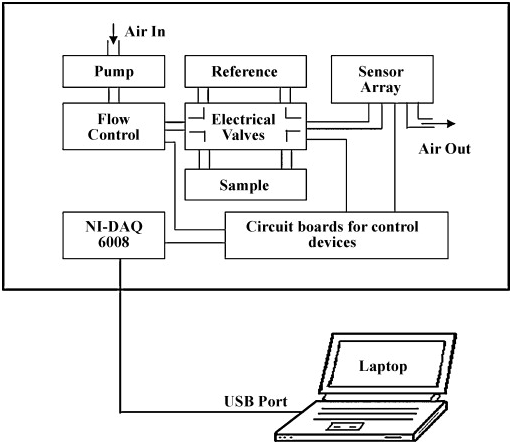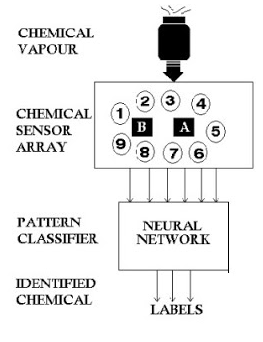Introduction:
Over the last decades, “electronic sensing” or “e-sensing” technologies have undergone important developments from a technical and commercial point of view. E-Sensing is the ability to reproduce human senses using the sensor array and pattern recognition system. An electronic nose is such an instrument that is designed to mimic the mammalian olfactory system.
What is e-Nose?
An electronic nose (e-Nose) is a device that identifies specific components of an odor and analyzes its chemical makeup to identify it.

Working Principle:
The electronic nose consists of three major parts which are detecting system, computing system, sample delivery system.
i. Sample Delivery System: This system generates a sample for analysis and then injected into the detection system.
ii. Detection System: The group of sensors in a detection system reacts to the flavor or odor present in a compound and generated an electrical signal based on the flavor. This electrical signal is then recorded by an electronic interface to get transformed into a digital signal.
iii. Computing System: The responses from all the sensors are combined to produce a final result. There will be a database collection of samples that are already processed and the result is analyzed based on that database. The computing system recognizes the pattern and gives us the desired result.

Sensor Technology in Electronic Nose:
The sensor array is clearly the key element. It forms the primary step in the detection or identification of an odorant.
The more commonly used sensors for electronic noses include:
Conductivity Sensors:
i. MOS (Metal oxide sensors): Adsorption of gas molecules provoke changes in conductivity. This conductivity change is the measure of the amount of volatile organic compounds adsorbed.
ii. Conducting polymers: Each polymer changes its size, and therefore its resistance, by a different amount, making a pattern of the change. If a different compound had caused the polymer to change, the pattern of polymer films’ change would have been different.
Piezoelectric Sensors: Adsorption of gas onto the surface of the polymer leads to a change in mass on the sensor surface. This, in turn, produces a change in the resonant frequency of the crystal. This change in frequency is proportional to the concentration of the test material.
MOSFET (Metal Oxide Silicon Field Effect Transistor) Sensors: The working principle of MOSFET is that molecules that enter into the sensor area will have a direct effect on the electric field inside MOSFET. A volatile organic compound produces a reaction in the sensing layer(gate). This causes the physical property of the gate to change. Thereby the threshold voltage is changed and thus the channel conductivity.
Optical Sensors: Optical sensor systems are somewhat more complex than typical sensor-array systems having transduction mechanisms based on changes in electrical resistance. Optical sensors work by means of light modulation measurements.
Data Analysis for Electronic Nose:
The digital output generated by electronic nose sensors has to be analyzed and interpreted in order to provide. There are three main types of commercially available techniques.
i. Graphical Analysis: It is the simplest form of data reduction. It is useful for comparing samples or comparing smells. it also helps in identifying elements of unknown analysts relative to those of known sources in reference libraries.
ii. Multivariate Data Analysis: This technique is very useful when sensors have partial sensitivities to individual compounds present in a sample mixer.
iii. Network Analysis: It is the best known and most derived analysis techniques utilized in a statistical software package for the commercially available electronic nose.

Applications of Electronic Nose:
– Medical diagnosis and health monitoring.
– Respiratory disease diagnosis
E-nose can diagnose respiratory infections such as pneumonia. It does so by comparing smell prints from the breath of a sick patient with those of patients with standardized readings. It is also being studied as a diagnostic tool for lung cancer.
– Urinary Tract infections
The e-nose is seen as a potential diagnostic tool for patients affected with kidney diseases, by distinguishing traces of blood in urine samples.
– Cancer detection
Human breath contains thousands of volatile organic compounds (VOCs) in the gas phase. E-nose is capable of distinguishing between the breath of a healthy person and a person with cancer. The device is especially promising because it can detect cancer before tumors become visible in X-rays.
– Environmental monitoring
An e-nose can be used for analyzing fuel mixtures, detection of oil leaks, testing groundwater for odors, identification of household odors, identification of toxic wastes, air quality monitoring, monitoring factory emissions, etc.
– Application in the food industry
One way by which an e-nose can be used in the food industry is the analysis of fruit ripening. Fruit ripening is associated with an accumulation of aromatic volatiles during ripening. Information from the e-nose can help in the removal of rotten fruits at the appropriate time. This can help in avoiding storage losses due to rots and fruit diseases.
– Detection of explosive
E-nose is being developed for military and security applications in the detection of explosives and hazardous chemicals.
– Space applications (NASA)
NASAJPL Electronic Nose (e-nose): It is a full-time, continuously operating event monitor used in the International Space Station. It is designed to detect air contamination from spills and leaks in the crew habitat. It provides rapid, early identification and quantification of atmospheric changes caused by chemical species to which it has been trained. It can also be used to monitor cleanup processes after a leak or a spill.
– Quality control laboratories
In quality control laboratories, e-nose can be used for checking the conformity of raw materials, intermediate and final products. It can also be used to check batch to batch consistency. Detection of contamination, spoilage, adulteration, monitoring of storage conditions, are some of its other uses.
Conclusion:
An “Electronic Nose” is a system originally created to copy the function of an animal nose, which cannot totally replace the animal nose but, can be used for different reasons with better advancements in technology in the future.
References:
https://www.elprocus.com/electronic-nose-work/
https://howtechnologywork.000webhostapp.com/how-electronic-nose-works/